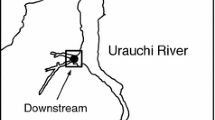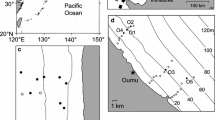Abstract
Coastal and estuarine ecosystems in the eastern channel and southern bight of the North Sea provide nursery habitats for juvenile fishes. We examined the age 0-group juveniles of three flatfish speciesSolea solea, Limanda limanda and Pleuronectes platessa, collected in five nursery areas with different characteristics (three sites located near small estuaries and two affected by important inputs of industrial effluents), to evaluate habitat influence on their growth and condition. We measured a biochemical index (RNA:DNA ratio), a morphometric index (Fulton’s K condition index), plus a recent growth index (marginal otolith increment width) on each individual (about 3 months old), collected during surveys in autumn 1999. The three indices displayed few significant differences among the five nursery sites and different patterns for each species. We suggest that the investigated nursery areas provide habitats of equivalent quality for the age 0-group juvenile flatfishes in spite of different anthropogenic disturbances. On the other hand, this study focuses on the importance of using different biological indicators to assess habitat quality and environmental stressors in coastal areas.
Similar content being viewed by others
References
Able, K. W., J. P. Manderson & A. L. Studholme. 1999. Habitat quality for shallow water shes in urban estuary:the effect of man-made structures on growth. Marine Ecol. 187:227–235.
Adams, S. M. (ed. ) 2002. Biological indicators of aquatic eco-system stress, American Fisheries Society, Bethesda, Maryland. 621 pp.
Adams, S. M., A. M. Brown & R. W. Goede. 1993. A quantitative health index for rapid evaluation of fish condition in the field. Trans. Am. Fish. Soc. 122:63–73.
Amara, R. 2003. Ichtyodiversity and population dynamics of 0–group flatfish on a nursery ground in the southern Bigth of the North Sea (France). Environ. Biol. Fishes 67:191–201.
Amara, R., P. Laffargue, J. M. Dewarumez & C. Maryniak. 2001. Feeding ecology and growth of 0–group flatfishes (sole, dab and plaice)on a nursery ground (Southern Bight of North Sea). J. Fish Biol. 58:788–803.
Bolger, T. & P. L. Conolly. 1989. The selection of suitable indices for the measurement and analysis of fish condition. J. Fish Biol. 34:171–182.
Brylinski, J. M., C. Brunet, D. Bentley, G. Thoumelin & D. Hilde. 1996. Hydrography and phytoplankton biomass in the eastern English Channel in spring 1992. Estuarine Coastal Shelf Sci. 43:507–519.
Buckley, L., E. Caldarone & T.-L. Ong. 1999. RNA-DNA ratio and other nucleic acid-based indicators for growth and condition of marine fishes. Hydrobiologia 401:265–277.
Burke, J. S., D. S. Peters & P. J. Hanson. 1993. Morphological indices and otolith microstructure of Atlantic croaker, Micropogonias undalatus, as indicators of habitat quality along an estuarine pollution gradient. Environ. Biol. Fishes 36:25–33.
Campana, S. E. & J. D. Neilson. 1985. Microstructure of fish otolith. Can. J. Fish. Aquatic Sci. 42:1014–1032.
Desroy, N., C. Warembourg, J. M. Dewarumez & J. C. Dauvin. 2003. Macrobenthic resources of the shallow soft-bottom sediments in the eastern Channel and southern North Sea. ICES J. Marine Sci. 60:120–131.
Fechhelm, R. G., W. B. Griffiths, W. J. Wilson, B. J. Gallaway & J. D. Bryan. 1995. Intra and interseasonal changes in relative condition and proximate body composition of broad whitefish from the Prudhoe Bay Region of Alaska. Trans. Am. Fish. Soc. 124:508–519.
Ferron, A. & W. C. Legett. 1994. An appraisal of condition measures for marine sh larvae. Adv. Marine Biol. 30:217–303.
Gibson, R. N. 1994. Impact of habitat quality and quantity on the recruitment of juvenile flatfishes. Netherlands J. Sea Res. 32:191–206.
Gilliers, C., O. Le Pape, Y. Désaunay, J. P. Bergeron, N. Schreiber, D. Guérault & R. Amara. Growth and condition of juvenile sole (Solea solea L. )as indicators of habitat quality in coastal and estuarine nurseries in the Bay of Biscay. Scientia Marina (in press).
Grosse, D. J., P. M. Scholz, M. F. Hirsh eld, G. M. Meaburn & M. Fletcher. 1997. Fisheries and pollution:an overview. Trans. Am. Fish. Soc. 126:1357–1380.
Karakiri, M., R. Berghahn & H. von Westernhagen. 1989. Growth differences in 0–group plaice Pleuronectes platessa as revealed by otolith microstructure analysis. Marine Ecol. Prog. Ser. 55:15–22.
Karsten, U. & A. Wollenberger. 1977. Improvement of the ethidium bromide method for direct estimation of DNA and RNA in cell and tissue homogenates. Anal. Biochem. 77: 464–470.
Koutsikopoulos, C., M. Karakiri, Y. Désaunay & D. Dorel. 1989. Response of juvenile sole (Solea solea L. )to environ-mental changes investigated by otolith microstructure anal-ysis. Rapport. P.-v. Réunion du Conseil International pour l ' Exploration de la Mer 191:281–286.
Lambert, Y. & J. D. Dutil. 1997. Can simple condition indices be used to monitor and quantify seasonal changes in the energy reserves of Atlantic cod (Gadus morhua ). Can. J. Fish. Aquatic Sci. 54(Supplement 1):104–112.
Le Pape, O., F. Chauvet, S. Mahévas, L. Lazure, G. Guérault & Y. Désaunay. 2003. Quantitative description of habitat suit-ability for the juvenile common sole (Solea solea L. )and contribution of different habitats to the adult population in the Bay of Biscay (France). J. Sea Res. 50:139–149.
Le Pecq, J. B. & C. Paoletti. 1966. A new fluorimetric method for RNA and DNA determination. Anal. Biochem. 17:100–107.
Lloret, J. & S. Planes. 2003. Condition, feeding and reproduc-tive potential of white seabream (Diplodus sargus )as indicators of habitat quality and the effect of reserve protection in the northwestern Mediterranean. Marine Ecol. Prog. Ser. 248:197–208.
McCormick, M. I. & B. W. Molony. 1993. Quality of a reef sh Upeneus tragula (Mullidae)at settlement:is size a good indicator of condition? Marine Ecol. Prog. Ser. 98:45–54.
Phelan, B. A., R. Goldberg, A. J. Bejda, J. Pereira, S. Hagan, P. Clark, A. L. Studholme, A. Calabrese & K. W. Able. 2000. Estuarine and habitat-related differences in growth rates of young of the year winter flounder (Pseudopleuronectes americanus )and tautog (Tautoga onitis )in three north-eastern US estuaries. J. Experiment. Marine Biol. Ecol. 247:1–28.
Reichert, M. J. M., J. M. Dean, R. J. Feller & J. M. Grego. 2000. Somatic growth and otolith growth in juvenile of a small tropical flatfish, the fringed flounder, Etropus crossotus. J. Experiment. Marine Biol. Ecol. 254:169–188.
Richard, P., J. P. Bergeron, M. Boulhic, R. Galois & J. Person-Le Ruyet. 1991. Effect of starvation on RNA, DNA and protein content of laboratory-reared larvae and juveniles of Solea solea. Marine Ecol. Prog. Ser. 72:69–77.
Riou, P., O. Le Pape & S. I. Rogers. 2001. Relative contributions of different sole and plaice nurseries to the adult pop-ulation in the eastern Channel:application of a combined method using generalized linear models and a geographic information system. Aquatic Living Resources 14:125–135.
Stunz, G. W., T. J. Minello & P. S. Levin. 2002. Growth of newly settled red drum Sciaenops ocellatus in different estuarine habitat types. Marine Ecol. Prog. Ser. 238:227–236.
Suthers, I. M., A. Fraser & K. T. Frank. 1992. Comparison of lipid, otolith and morphometric condition indices of pelagic juvenile cod (Gadus morhua )from the Canadian Atlantic. Marine Ecol. Prog. Ser. 84:31–40.
Suthers, I. M. 1998. Bigger? fatter? or is faster growth better? Considerations on condition in larval and juvenile coral-reef fish. Australian J. Ecol. 23:265–273.
Vila-Gispert, A., L. Zamora & R. Moreno-Amich. 2000. Use of Mediterranean barbel (Barbus meridionalis )to assess habitat quality in stream ecosystems. Archiv fur Hydrobiologie 148:135–145.
Author information
Authors and Affiliations
Rights and permissions
About this article
Cite this article
Gilliers, C., Amara, R. & Bergeron, JP. Comparison of growth and condition indices of juvenile flatfish in differentcoastal nursery grounds. Environmental Biology of Fishes 71, 189–198 (2004). https://doi.org/10.1007/s10641-004-0090-2
Issue Date:
DOI: https://doi.org/10.1007/s10641-004-0090-2




